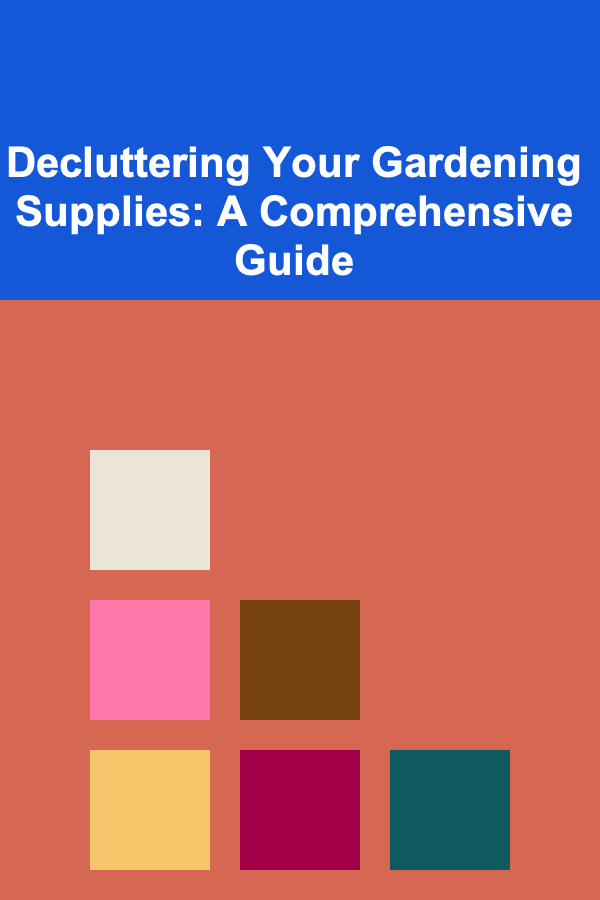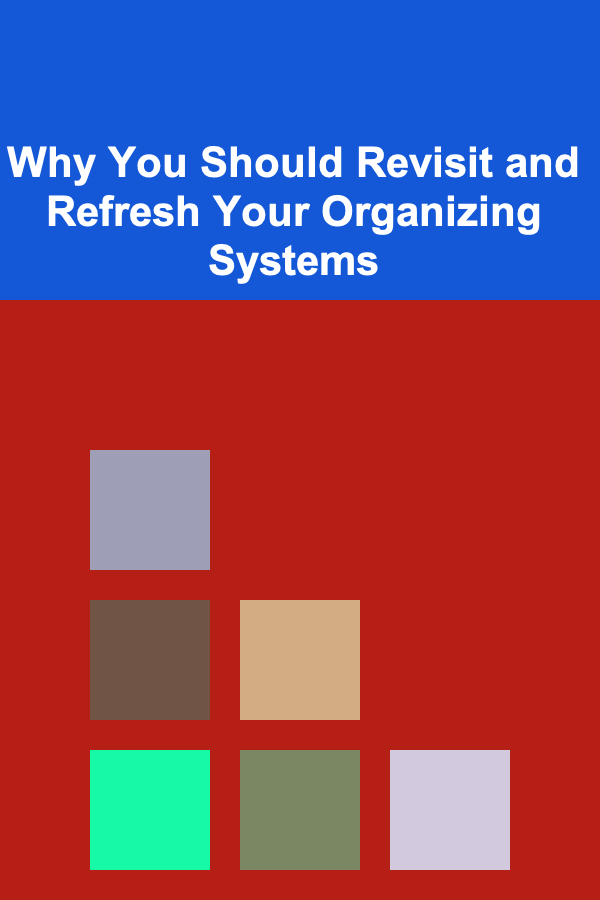
Decluttering Your Gardening Supplies: A Comprehensive Guide
ebook include PDF & Audio bundle (Micro Guide)
$12.99$8.99
Limited Time Offer! Order within the next:

Gardening, a rewarding and therapeutic activity, often leads to the accumulation of tools, pots, fertilizers, and other supplies. Over time, these items can create clutter, making it difficult to find what you need and diminishing the joy of gardening. Decluttering your gardening supplies is essential for creating a more organized, efficient, and enjoyable gardening experience. This comprehensive guide will walk you through the process, offering practical tips and strategies to help you reclaim your space and rediscover the pleasure of tending to your garden.
Why Declutter Your Gardening Supplies?
Before diving into the "how," let's consider the "why." Decluttering your gardening supplies offers numerous benefits:
- Improved Efficiency: Knowing where everything is saves time and reduces frustration. You'll spend less time searching for tools and more time gardening.
- Enhanced Safety: Cluttered spaces can be hazardous. Sharp tools lying around pose a risk of injury. A well-organized space minimizes accidents.
- Cost Savings: You'll avoid buying duplicates of items you already own but can't find. A clear inventory helps you make informed purchasing decisions.
- Reduced Stress: A clean and organized gardening space promotes a sense of calm and control, making gardening more relaxing and enjoyable.
- Better Equipment Maintenance: When tools are organized and accessible, you're more likely to clean and maintain them properly, extending their lifespan.
- Space Optimization: Decluttering frees up valuable storage space, allowing you to better organize your garden and potentially even expand your gardening area.
Step 1: The Initial Assessment - Understanding the Scope
The first step in decluttering is a thorough assessment of your current gardening supplies. This involves taking stock of everything you have and understanding the extent of the clutter.
Gather Everything in One Place
Bring all your gardening supplies together in a single location. This could be your garage, shed, basement, or any space where you store your gardening equipment. Consolidating everything allows you to see the full extent of your collection.
Take Inventory
Carefully examine each item and create an inventory. This can be a physical list or a digital one. Consider the following categories:
- Tools: Shovels, rakes, hoes, trowels, pruners, loppers, watering cans, hoses, etc.
- Pots and Containers: Clay pots, plastic pots, hanging baskets, seed trays, etc.
- Fertilizers and Chemicals: Fertilizers, pesticides, herbicides, soil amendments, etc.
- Seeds and Bulbs: Seed packets, bulb collections, etc.
- Gardening Accessories: Gloves, kneeling pads, plant labels, twine, stakes, etc.
- Miscellaneous Items: Gardening books, magazines, decorative items, etc.
Evaluate Each Item
For each item on your inventory, ask yourself the following questions:
- Do I use this item regularly?
- Is this item in good working condition?
- Do I have duplicates of this item?
- Could I borrow or rent this item instead of owning it?
- Do I truly need this item for my gardening activities?
Step 2: The Four-Box Method - Sorting and Categorizing
The four-box method is a simple yet effective way to sort your gardening supplies. Create four designated areas or boxes labeled:
- Keep: Items you use regularly and are in good working condition.
- Donate/Sell: Items in good working condition that you no longer need.
- Repair: Items that are broken but can be fixed.
- Trash: Items that are broken beyond repair or no longer useful.
Carefully go through each item on your inventory and place it in the appropriate box. Be honest with yourself about what you truly need and use. It's easy to hold onto items "just in case," but this often leads to unnecessary clutter.
The "Keep" Box: Essential Items
The "Keep" box should contain only the essential items that you use frequently and are in good working condition. This might include:
- Your favorite gardening tools (shovel, rake, trowel, pruners).
- Essential pots and containers for your plants.
- Fertilizers and chemicals that you regularly use.
- Seeds and bulbs for plants you plan to grow.
- Gardening gloves and other protective gear.
The "Donate/Sell" Box: Giving Items a New Life
The "Donate/Sell" box should contain items that are in good working condition but you no longer need. Consider the following options:
- Donate to a local gardening club or community garden.
- Sell items at a garage sale or online marketplace.
- Donate to a thrift store.
- Give items to friends or neighbors who garden.
The "Repair" Box: Fixing What's Broken
The "Repair" box should contain items that are broken but can be fixed. Before placing an item in this box, consider the following:
- Is it worth the time and effort to repair this item?
- Do I have the skills and resources to repair this item myself?
- Is it more cost-effective to repair the item or buy a new one?
If you decide to repair an item, set a deadline for completing the repair. If the repair is not completed by the deadline, consider moving the item to the "Trash" box.
The "Trash" Box: Letting Go
The "Trash" box should contain items that are broken beyond repair or no longer useful. Be honest with yourself about what can be salvaged. Dispose of these items responsibly.
- Recycle any recyclable materials.
- Dispose of hazardous materials properly according to local regulations.
Step 3: Organizing Your Remaining Supplies
Once you've decluttered your gardening supplies, it's time to organize the remaining items in the "Keep" box. A well-organized space makes it easier to find what you need and encourages you to maintain the organization.
Choose the Right Storage Solutions
Select storage solutions that are appropriate for your space and the types of items you need to store. Consider the following options:
- Shelving: Shelving units are ideal for storing pots, fertilizers, and other bulky items.
- Pegboards: Pegboards are perfect for hanging tools and keeping them within easy reach.
- Storage Bins: Storage bins are useful for organizing small items like seeds, gloves, and plant labels. Clear bins allow you to easily see what's inside.
- Tool Racks: Tool racks are designed to hold long-handled tools like shovels and rakes.
- Potting Benches: Potting benches provide a convenient workspace for potting plants and storing supplies.
Maximize Vertical Space
Utilize vertical space by installing shelves, pegboards, or hanging baskets. This helps to keep items off the floor and maximizes storage capacity.
Group Similar Items Together
Organize your supplies by category. For example, group all your hand tools together, all your pots together, and all your fertilizers together. This makes it easier to find what you need when you need it.
Label Everything
Label all your storage containers and shelves. This helps you quickly identify the contents and encourages you to put items back in their proper place.
Create Zones
Divide your gardening space into zones based on activity. For example, create a potting zone, a tool storage zone, and a fertilizer storage zone. This helps to streamline your gardening tasks.
Prioritize Accessibility
Store frequently used items in easily accessible locations. Less frequently used items can be stored on higher shelves or in less convenient areas.
Step 4: Maintaining an Organized Gardening Space
Decluttering is not a one-time event; it's an ongoing process. To maintain an organized gardening space, follow these tips:
Put Items Back After Use
Make it a habit to put tools and supplies back in their designated place after each use. This prevents clutter from accumulating and keeps your space organized.
Regularly Assess Your Supplies
Take a few minutes each month to assess your gardening supplies. Discard any broken or unused items. Donate or sell items that you no longer need.
One In, One Out
Whenever you purchase a new gardening item, consider getting rid of an old one. This helps to prevent clutter from accumulating.
Clean and Maintain Your Tools Regularly
Clean your tools after each use to prevent rust and corrosion. Sharpen blades as needed. This extends the lifespan of your tools and keeps them in good working condition.
Seasonal Decluttering
At the end of each gardening season, take the time to declutter and organize your supplies. This prepares you for the next season and ensures that you have everything you need.
Specific Item Considerations: A Deeper Dive
Let's consider some specific categories of gardening supplies and how to declutter them effectively.
Pots and Containers
Pots and containers can quickly accumulate, especially if you propagate plants or like to experiment with different styles. Decluttering pots involves:
- Assessing Condition: Discard any cracked, broken, or heavily stained pots.
- Matching Size to Need: If you have a surplus of small pots but primarily grow larger plants, consider donating or selling the smaller pots.
- Stacking and Nesting: Store pots of similar sizes together to save space. Nesting pots within each other is an efficient storage technique.
- Considering Alternative Uses: Before discarding, think about repurposing pots. Broken pots can be used for drainage in larger containers, and terracotta shards can add a rustic touch to your garden.
Fertilizers and Chemicals
Fertilizers and chemicals require careful handling and storage. Decluttering this category involves:
- Checking Expiration Dates: Many fertilizers and chemicals have expiration dates. Discard any expired products according to local regulations.
- Proper Storage: Store fertilizers and chemicals in a cool, dry, and well-ventilated area, away from children and pets.
- Consolidating Partially Used Containers: If you have multiple partially used containers of the same product, combine them into one container to save space.
- Considering Organic Alternatives: Explore organic gardening methods and reduce your reliance on chemical fertilizers and pesticides. This can simplify your storage needs.
- Safe Disposal: Never pour unused chemicals down the drain or into the ground. Contact your local waste management authority for proper disposal instructions.
Seeds and Bulbs
Seeds and bulbs can lose their viability over time. Decluttering this category involves:
- Checking Viability: Test the germination rate of older seeds before planting. If the germination rate is low, discard the seeds.
- Proper Storage: Store seeds in a cool, dry, and dark place. Seed packets can be stored in airtight containers or seed organizers.
- Organizing by Type and Season: Group seeds and bulbs by type (e.g., vegetables, flowers) and planting season (e.g., spring, fall).
- Labeling and Dating: Clearly label all seed packets and bulb containers with the date of purchase or collection.
- Sharing with Others: Share surplus seeds and bulbs with friends, neighbors, or local gardening clubs.
Hand Tools
Hand tools are essential for gardening, but they can easily become cluttered. Decluttering this category involves:
- Sharpening and Cleaning: Regularly sharpen and clean your hand tools to keep them in good working condition.
- Organizing by Use: Group tools by function (e.g., digging tools, pruning tools, weeding tools).
- Hanging on Pegboards or Tool Racks: Use pegboards or tool racks to hang tools and keep them within easy reach.
- Storing in a Tool Bag or Bucket: Keep a tool bag or bucket handy for carrying tools around the garden.
- Replacing Broken or Worn Tools: Replace any broken or worn tools with new ones. Consider donating or selling older tools that are still in good working condition.
Hoses and Watering Equipment
Hoses and watering equipment can take up a lot of space. Decluttering this category involves:
- Proper Storage: Store hoses on hose reels or hangers to prevent kinks and tangles.
- Repairing Leaks: Repair any leaks in your hoses or watering equipment.
- Cleaning Nozzles: Clean nozzles regularly to prevent clogging.
- Choosing the Right Size: Select hoses that are the appropriate length for your garden. Avoid using excessively long hoses that can be difficult to manage.
- Considering Soaker Hoses or Drip Irrigation: Explore soaker hoses or drip irrigation systems to reduce water waste and simplify watering.
Beyond the Physical: Digital Decluttering
In the modern age, gardening extends beyond the physical realm. Digital clutter related to gardening can also contribute to overwhelm. Consider these digital decluttering strategies:
- Organize Digital Photos: Categorize and delete duplicate or blurry photos of your garden.
- Unsubscribe from Unnecessary Email Lists: Reduce email clutter by unsubscribing from gardening newsletters you no longer read.
- Organize Gardening Apps: Delete apps you no longer use and organize the remaining apps into folders.
- Back Up Important Information: Back up important gardening information, such as plant lists, garden plans, and planting schedules.
- Streamline Online Resources: Bookmark useful websites and blogs related to gardening and delete outdated bookmarks.
The Mental Benefits of a Decluttered Gardening Space
While the practical benefits of decluttering your gardening supplies are undeniable, the mental benefits are equally significant. A decluttered space:
- Reduces Stress and Anxiety: A clean and organized space promotes a sense of calm and control.
- Increases Focus and Productivity: A decluttered space allows you to focus on your gardening tasks without distractions.
- Enhances Creativity and Inspiration: A clean and organized space can spark creativity and inspire new gardening ideas.
- Improves Overall Well-being: A well-maintained garden and gardening space contribute to a sense of accomplishment and satisfaction.
Conclusion: Cultivating a Clutter-Free Gardening Oasis
Decluttering your gardening supplies is an investment in your well-being and the health of your garden. By following the steps outlined in this guide, you can create a more organized, efficient, and enjoyable gardening experience. Remember that decluttering is an ongoing process, not a one-time event. By incorporating regular decluttering habits into your gardening routine, you can maintain a clutter-free space and rediscover the joy of tending to your garden. So, take the first step today and embark on your decluttering journey. Your garden (and your mind) will thank you for it!

How to Choose the Best Neighborhood Watch Program for Your Area
Read More
How to Create a Festive Holiday Tablescape for Dinner Parties
Read More
How to Use SMS to Offer Discounts and Incentives for Abandoned Cart Recovery in Dropshipping
Read More
The Brand Manager's Guide: Mastering Brand Strategy and Growth
Read More
Why You Should Revisit and Refresh Your Organizing Systems
Read More
How to Automate Cloud Infrastructure Provisioning
Read MoreOther Products

How to Choose the Best Neighborhood Watch Program for Your Area
Read More
How to Create a Festive Holiday Tablescape for Dinner Parties
Read More
How to Use SMS to Offer Discounts and Incentives for Abandoned Cart Recovery in Dropshipping
Read More
The Brand Manager's Guide: Mastering Brand Strategy and Growth
Read More
Why You Should Revisit and Refresh Your Organizing Systems
Read More